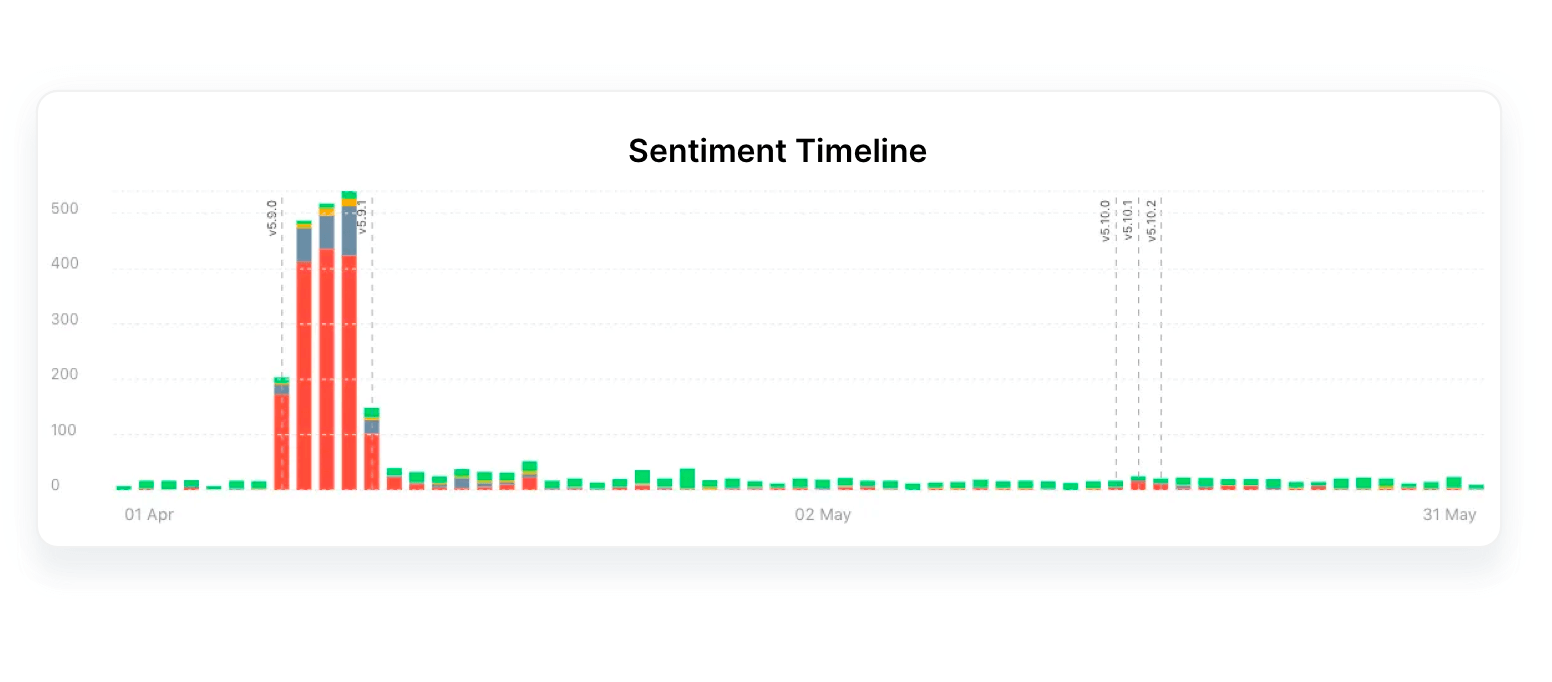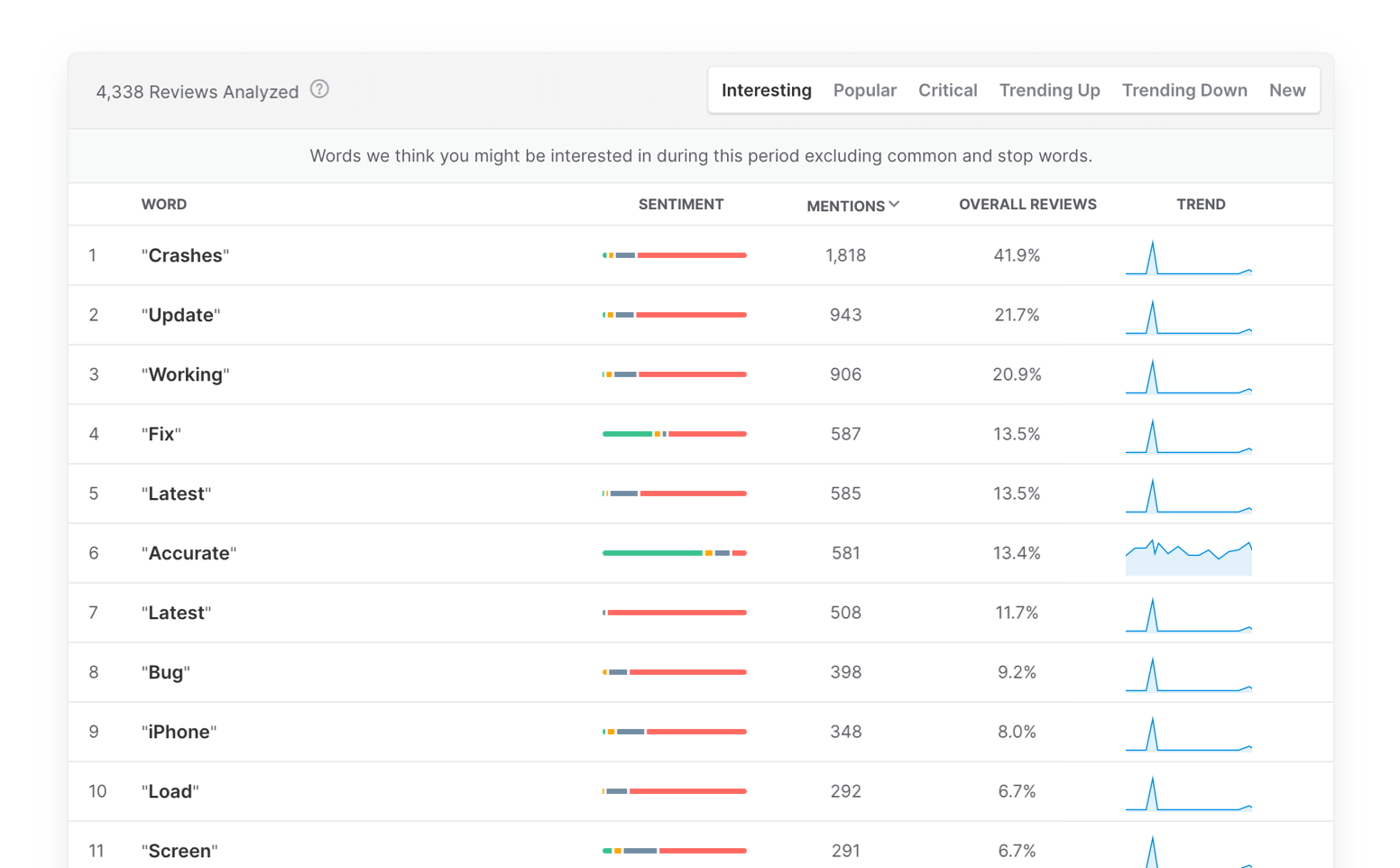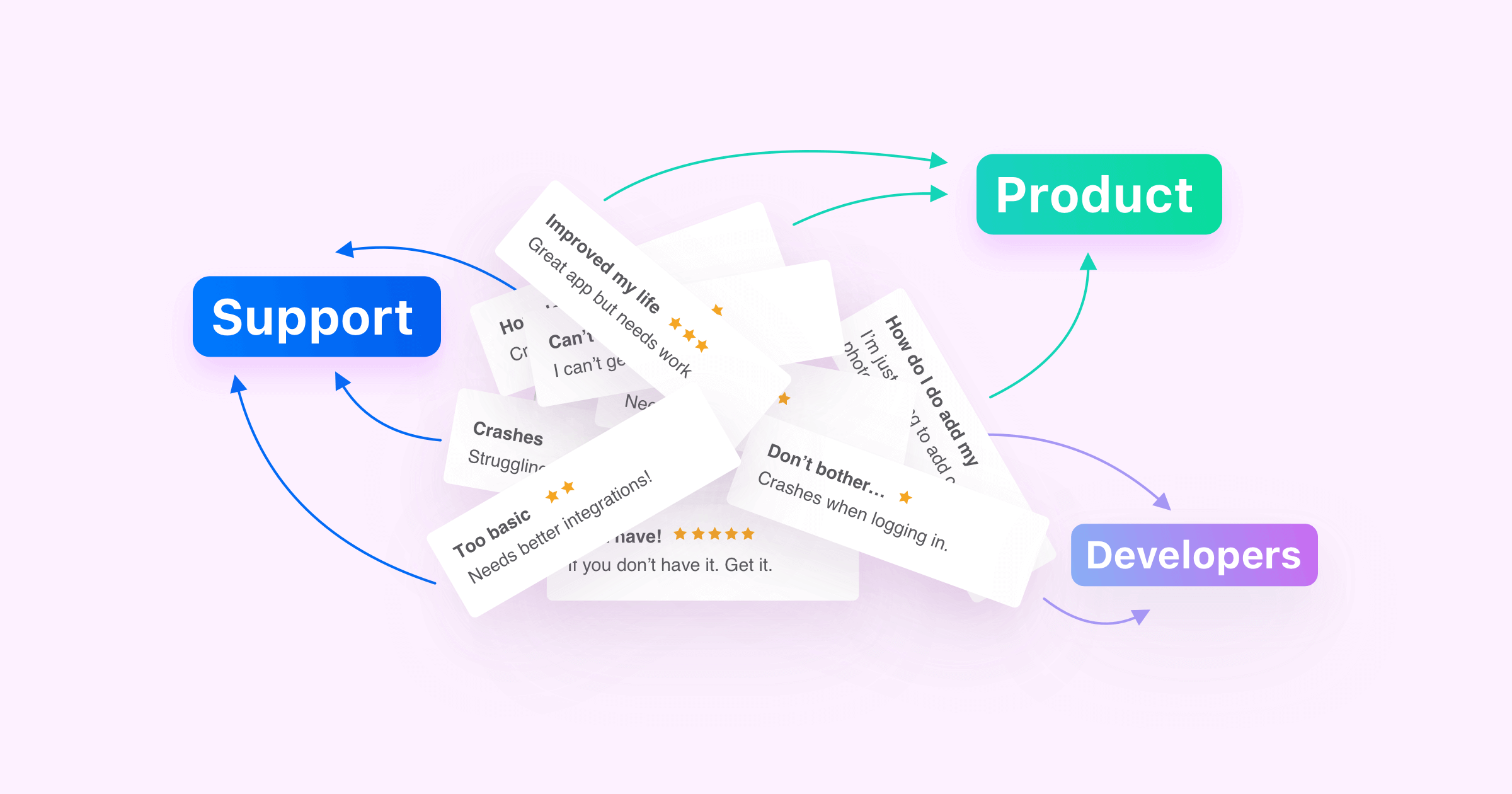The app review & rating checklist
Published 26th May, 2020 by Claire McGregor Reviews and ratings have a huge impact on the success of an app. The major app stores have been open about the importance of reviews and ratings in recent years; Apple even directly state on their public developer guide that ratings, reviews and review replies affect rankings and the likelihood of receiving a download.
Reviews and ratings have a huge impact on the success of an app. The major app stores have been open about the importance of reviews and ratings in recent years; Apple even directly state on their public developer guide that ratings, reviews and review replies affect rankings and the likelihood of receiving a download. In this overview you'll learn to:
- 1. Use Ratings prompts effectively
- 2. Analyze review comments to find opportunities to improve
- 3. Put that feedback to work
- 4. Replies are important!
Want to analyze & categorize app reviews in minutes?
Join over 25% of the Fortune 100 and 35% of the top charting app developers using Appbot.
Try Appbot free now, no credit card needed →Generating a meaningful volume of reviews with positive comments and 4 or 5 star ratings is no mean feat. The good news is that the world's most popular apps follow a playbook in order to achieve this, and you can follow it to.
In the sections below we'll explore best practices used by top charting apps to get more (and better) reviews and put review feedback to good use.
1. Use Ratings prompts effectively
Ratings prompts are the most important tool app developers have to help them increase their review volume.
Very few users will leave an app review without prompting. Some amazing results for ratings prompts have been published in recent years, like Instagram's crazy 400% rating increase in 2 weeks!
Some app stores impose limits on how often you can prompt users to leave a review. It is therefore very important to make sure you use your prompts effectively.
When setting up your rating and review prompts it pays to put yourself in the shoes of your users. The goal is to ask users to leave a review:
- When the user has just experienced the first “wow” moment in your app. Don't ask too early, or the user will feel they don't know enough to give a Rating (or will be annoyed and give you 1 or 2 stars!).
- At the natural end of a workflow or task - avoid interrupting users at all costs.
- When the user is likely to be feeling satisfaction with your app. This maximises your chances of a positive rating and review.
What works for one app won't necessarily work for another. Consider the persona(e) of your users and why they downloaded your app. Ultimately, perfecting the timing and location of your prompts is something each app needs to test and measure.
2. Analyze review comments to find opportunities to improve
There are two key analytical techniques used on app reviews by the world's top charting apps; sentiment analysis and text mining (sometimes called natural language processing or NLP).
Sentiment analysis is an analytical technique that uses software to parse a piece of text and determine whether it is positive, neutral or negative. This technique only uses reviews (a rating with a comment, rather than just a rating), as it requires some text to analyze. Mapping shifts in user sentiment to the release of new versions of your app can really help you to understand your customers' reaction at a macro level.
Every team hopes to see something like this sentiment timeline. The last two version updates have delivered both a growth in total review count and an increase in the proportion of reviews that are positive.

We are all aiming to avoid sentiment analysis charts that look like this data from a weather app. Note the correlation between the dotted lines that mark the release of a product and the sharp spike in reviews with negative sentiment.

Although it is initially upsetting to see this reaction from users, being aware of the negative backlash makes it possible for you to start to dig into the reasons for such negative responses.
“Why not just rely on the star rating?” you ask… There are several reasons.
A recent Appbot analysis of 6 million app reviews revealed that 7-8% of the sample was classified as having a mixed sentiment. Mixed sentiment describes reviews where the star rating is at odds with the sentiment of the review text - a high star rating with a negative comment, or vice versa. For reviews with mixed sentiment, star ratings can be misleading.
In addition, another recent study found that the overall ratings are on average 1.1 stars higher than the star ratings for reviews with a comment in the top 100 mobile apps. This suggests that users often use reviews to share complaints and concerns, or report bugs - things all app developers want to know about as soon as they affect user experience.
This leads us to the importance of text mining to help you spot the most important themes in your review data. These themes often highlight things like:
- Spikes in reports of a bug
- Which feature requests are most common
- Complaints about your pricing or monetization model
- Comparisons (positive or negative) to competitors
So what is text mining? Text mining is a term used to describe many different techniques, including the use of AI, that could help you analyze reviews by automatically grouping review data based on similarities in content.
Let's look at some practical examples using the same weather app we looked at above.
Using text mining you can analyze reviews based on the words they contain:

This analysis gives us some insight into:
- Why there have been so many negative reviews since the latest update
- Also, the thing that customers love about the app is shown in position 6!
Text mining also allows us to expand this analysis and see which phrases are most common:

This analysis offers more clues about when the issue is occuring - crashes are occurring upon opening the app.
As you get more comfortable with text mining you might consider using a tool that allows you to create your own more complex themes or topics to track over time.
As you can see, these techniques help you to get a quantitative view on the things that really matter to users. Humans have a natural bias to recency, which means we tend to think more recently reported issues are the most important, even if those issues are rarely reported. Text mining helps you give every user an equal voice, and unearth the biggest opportunities for improvement without guesswork.
3. Put that feedback to work
Having this information is awesome, but to really improve our apps we need to create a process to use this information effectively.
Putting this feedback to work will look substantially different from team to team so rather than be prescriptive in this section we will provide some ideas and inspiration for you to pick and choose from.
- Feed this data into your roadmap.
Quantitative data on problems and feature requests helps you prioritize the highest impact work, so you can see that reflected in star ratings ASAP.
- Keep your customer support team informed.
Sharing the most common problems arising in reviews can help your support team be better prepared and therefore give better, faster responses
- Use in your marketing
Understanding what customers value most about your app allows you to maximize the way you market those features in the app stores and in the app itself.
- Feed into your overall Voice of the Customer analysis
This helps put feedback from your apps into the context of your broader business, which is especially important if your app isn't the only product offering you have.
Be sure to keep users informed about the improvements you are making based on changes they requested or issues they reported. Leverage release notes when you ship those changes to make sure customers see that you're listening and, more importantly, acting.
4. Replies are important!
Finally, some notes on the value of replying to reviews on the app stores.
Replies you make on the app stores are (largely) publicly visible. This makes replies a great opportunity to show off your excellent customer support - a very compelling offering to prospects who are considering your app. Follow these best practices to craft replies users will view positively.
For some teams the volume of app reviews will make replying to all of them impossible. Don't worry if this is you (great problem to have!), use tools that allow you to spot the high value reviews to reply to. Different teams define “high value” differently, but it might involve some combination of low star reviews, reviews with negative sentiment and/or reviews reporting a problem (even if they gave you 4 or 5 stars).
We suggest using a tool that helps you identify reviews that meet your criteria for a reply, to keep your support team efficient. We also recommend reporting on the effect replies have on star ratings - quantifying the uplift in star rating for reviews you replied to can really help your management see the value in this exercise.
Right back at the beginning of this article we mentioned that Apple make reference to replying to users for both app discovery and for maximizing the chance of conversion to download. This suggests that replying to reviews might also help with your rankings in the App Stores and we recommend that you experiment with different levels of replies and see what effect it has.
In short…
We hope this guide has provided you with some useful inspiration on areas where your team can make better use of your reviews. Ask for reviews at the right time, use tools to help you understand the common themes in your reviews, implement changes in your app based on those themes, and take the opportunity to engage with users via replies. As you improve the way you approach each of these areas you'll see it reflected in your star ratings and, we hope, ultimately reflected in your revenues.
Want to analyze & categorize app reviews in minutes?
Join over 25% of the Fortune 100 and 35% of the top charting app developers using Appbot.
Try Appbot free now, no credit card needed →Where to from here?
- Utilize strategic app review prompts to encourage users to share their experiences.
- Explore Appbot's sentiment analysis tool to gain deeper insights into user sentiments and optimize your app accordingly.
- Engage with your users effectively by crafting thoughtful responses with Appbot's convenient Reply to App Store Reviews feature.
- Discover how to use app feedback as a way to improve your product and hence drive growth.
About The Author

Claire is the Co-founder & Co-CEO of Appbot. Claire has been a product manager and marketer of digital products, from mobile apps to e-commerce sites and SaaS products for the past 15 years. She's led marketing teams to build multi-million dollar revenues and is passionate about growth and conversion optimization. Claire loves to work directly with the world's top app companies delivering tools to help them improve their apps. You can connect with her on LinkedIn.
Enjoying the read? You may also like these
 5 tips for managing app store reviews and ratings
5 tips for managing app store reviews and ratings Excellence in app store review management is key when it comes to making apps more useful, beautiful & profitable. See our tips to manage reviews effectively.
Are App Store subscriptions better than one-off in-app purchases? Read about our subscription pricing experiments to the first $1k in MRR.
5-star review replies should be formed part of the business app reply strategy. Learn what makes up the components of an exceptional 5-star review reply.
When an app has a low rating, it can have a number of negative consequences for both the app developer and the users of the app.


